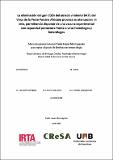Por favor, use este identificador para citar o enlazar a este item:
http://hdl.handle.net/10261/270367COMPARTIR / EXPORTAR:
 SHARE
BASE SHARE
BASE
|
|
| Visualizar otros formatos: MARC | Dublin Core | RDF | ORE | MODS | METS | DIDL | DATACITE | |

| Título: | La eliminación del gen CD2v del aislado virulento BA71 del visrus de la perste porcina africana provoca su atenuación in vivo, permitiendo disponer de una vacuna experimental con capacidad protectora frente a virus homólogo y heterólogos |
Autor: | López-Monteagudo, Paula | Director: | Rodríguez González, Fernando; Salas, María Luisa; Jaraquemada, Dolores | Palabras clave: | VPPA ASFV Vacuna atenuada Attenuated vacine Virologia Virology |
Fecha de publicación: | 9-sep-2015 | Editor: | Universidad Autónoma de Barcelona | Resumen: | [EN]: African swine fever (ASF) is a highly infectious hemorrhagic disease of compulsory declaration to the World Animal Health (OIE) and causes important economical losses in affected countries. The causative agent of the disease is African swine fever virus (ASFV), a large and complex virus against which there is no effective vaccine available and therefore, its control and eradication relies on the rapid diagnostic of the disease and culling of infected and/or exposed animals to the virus. ASF remains endemic in sub--Saharan Africa where the virus is in a sylvatic cycle between wild pigs and ticks, occasionally infecting highly susceptible domestic pigs. The virus re--entered Continental Europe in 2007 and since then, the virus has circulated from Georgia to the rest of the Caucasian Regions, Russia and more recently has entered the European Union borders. The main objective of this Thesis was developing a new vaccine strategy against ASF, based on the genetic manipulation of the ASFV genome. The main findings obtained can be summarized as follows: i) the deletion of the hemagglutinin gene or viral CD2, strongly attenuated the ASFV--BA71 virulent strain in vivo; ii) BA71. ΔCD2, a live attenuated virus defective for CD2v, is able to confer in vivo protection in a dose--dependent manner against the lethal challenge with either the homologous BA71 virus or the heterologous E75 virus; iii) Inoculation with the higher dose tested of BA71. ΔCD2, 106 PFU, conferred complete protection against BA71 and E75; iv) the cross--protection induced by BA71. ΔCD2 correlated with its ability to induce specific CD8+ T--cells capable to in vitro recognize both BA71 and E75 viruses; an effect observed for the first time for ASFV--attenuated viruses, capable only to confer protection against homologous viruses; v) Inoculation of 106 PFU of BA71. ΔCD2 protected 100% of the immunized pigs against lethal challenge with the virulent strain Georgia07, currently circulating in Europe. The encouraging results obtained during this Thesis open new expectations and strength our opinion about the possibility of obtaining a vaccine against ASFV. Despite these promising findings, this vaccine prototype should be refined to obtain a safer vaccine capable also of inducing a differential immune response from circulating ASF viruses; a must in Veterinary vaccines against diseases of compulsory declarations. [ES]: La peste porcina africana (PPA) es una enfermedad hemorrágica altamente infecciosa de declaración obligatoria a la Organización Mundial de la Salud Animal (OIE) y que provoca grandes pérdidas económicas en los países afectados. El agente causal de la enfermedad es el virus de la peste porcina africana (VPPA), un virus para el que todavía hoy no existe vacuna. El VPPA permanece endémico desde su origen en el África subsahariana, mantenido en un ciclo silvestre entre los cerdos salvajes y las garrapatas, infectando ocasionalmente a cerdos domésticos, altamente susceptibles a la enfermedad. Desde que en el año 2007 el virus volviera a entrar en la Europa continental, no ha parado de expandirse desde Georgia por todo el Cáucaso y Rusia, alcanzando en 2014 a varios países de la Unión Europea. El principal objetivo de esta Tesis fue desarrollar una nueva vacuna frente a la PPA basada en la manipulación genética del virus. Estos fueron los principales logros conseguidos: i) la deleción del gen de la hemaglutinina o CD2 viral del genoma de la cepa virulenta BA71, atenúa dramáticamente su patogenia in vivo. ; ii) El virus delecionado de CD2v, BA71. ΔCD2, es capaz de conferir protección frente a la infección letal con el virus homólogo virulento BA71, así como frente al virus heterólogo virulento E75, de una manera dosis dependiente; iii) La dosis más elevada ensayada de BA71. ΔCD2: 106 UFP, protegió totalmente a los animales frente a la infección letal con uno u otro aislado de VPPA; iv) La protección cruzada observada tras inmunizar con BA71. ΔCD2 correlaciona con la capacidad que este virus tiene de inducir células T--CD8+ que in vitro reconocen tanto a BA71 como a E75, mientras que los virus atenuados hasta ahora probados sólo protegían y reconocían únicamente a virus homólogos; iv) La inoculación de 106 UFP de BA71. ΔCD2 fue capaz de proteger al 100% de los cerdos vacunados frente a la infección con una dosis letal del virus heterólogo Georgia07, actualmente circulando por Europa. Los resultados obtenidos durante esta Tesis avalan la idea de que obtener una vacuna frente a PPA es posible, si bien es esencial aumentar su seguridad y dotarla de la capacidad de inducir una respuesta inmunológica que permita diferenciar a los animales vacunados de los infectados; clave sobre todo pensando en su utilización en zonas libres de la enfermedad. |
URI: | http://hdl.handle.net/10261/270367 | ISBN: | 9788449055126 |
| Aparece en las colecciones: | (CBM) Tesis |
Ficheros en este ítem:
| Fichero | Descripción | Tamaño | Formato | |
|---|---|---|---|---|
| La_eliminación_del_gen_CD2v_López_Agudo_Tesis.pdf | 4,43 MB | Adobe PDF |  Visualizar/Abrir |
CORE Recommender
Page view(s)
36
checked on 18-abr-2024
Download(s)
153
checked on 18-abr-2024
Google ScholarTM
Check
Altmetric
Este item está licenciado bajo una Licencia Creative Commons

